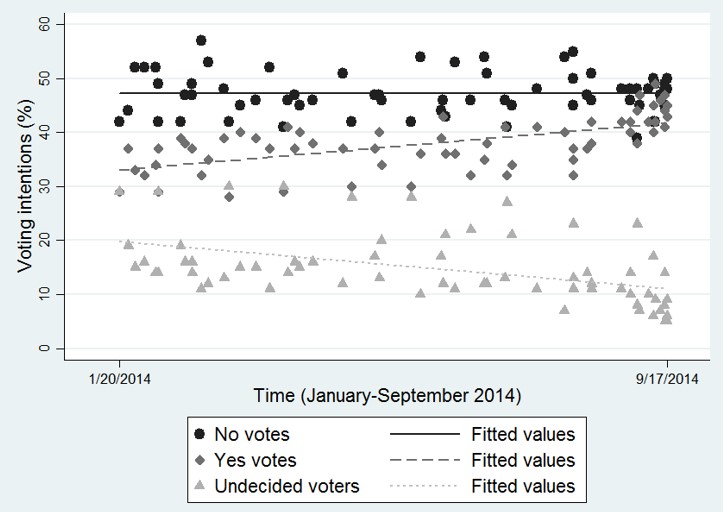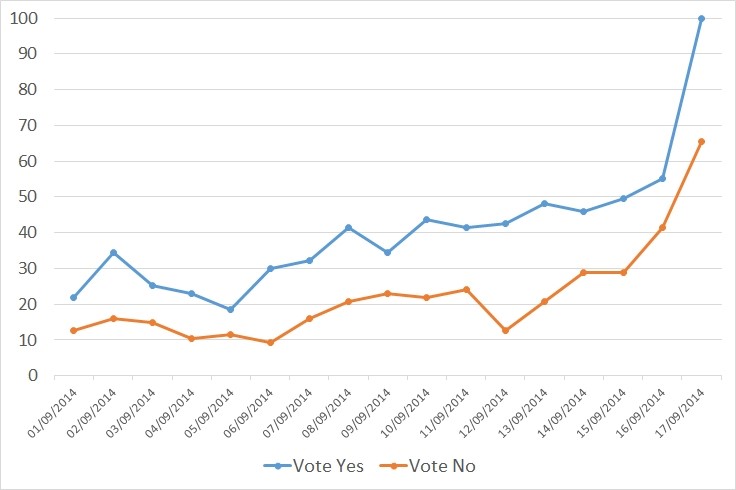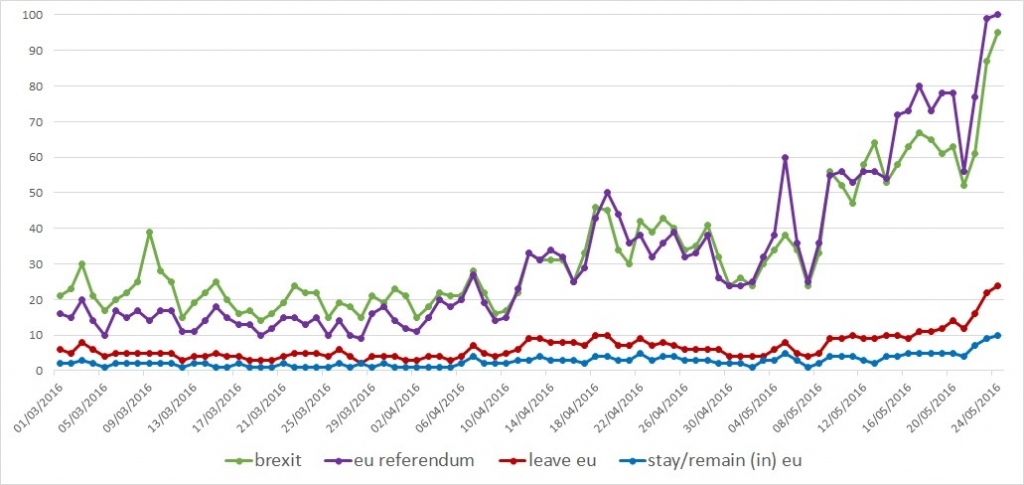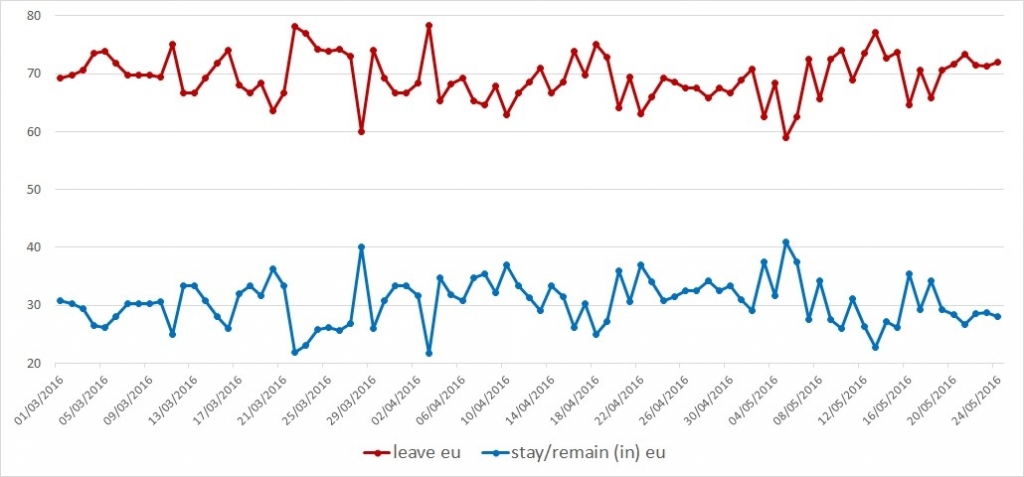Brexit and Scottish independence: Does campaign information actually change voters’ minds during a referendum?
Both sides of the UK’s referendum campaign have invested huge resources in trying to convince the electorate to back their viewpoint, but how effective are these efforts in actually changing the minds of voters? Drawing on research in the 2014 referendum on Scottish independence, Davide Morisi illustrates how information can have an impact on the views of the electorate. He notes that much like the pro-independence side in Scotland, the leave campaign’s success will hinge on whether they can convince voters that the risks associated with changing the status quo are worth taking.
A referendum implies two radically different choices. On the one hand, you can vote for a change, such as a constitutional change, the introduction of a new policy, or the approval of a new treaty. On the other, you can refuse the proposed change and maintain the status quo.
Although choosing the status quo does not necessarily correspond to the safest option, it does correspond to the less uncertain one. “Brexit is riskier than Bremain”, as Timothy Garton Ash wrote in relation to the upcoming EU referendum. But considering the intrinsic differences between referendum options, does information also have different effects on voting decisions?
The case of Scotland
In a recently published study, I explored this question in the context of the referendum for the independence of Scotland. Results based on experimental and survey data show that pro and anti-independence arguments did influence voting decisions in the campaign for the Scottish referendum, but this effect crucially depended on two elements: the share of undecided voters, and the imbalance between a riskier “yes” for independence and a safer “no” for remaining in the UK. The combination of these factors led to a one-sided persuasion effect of information, meaning that only support for independence significantly increased after exposure to a mixed set of arguments.
The results of this study find support in the analysis of two nationally representative surveys – the Scottish Social Attitude survey and the British Election Study Internet panel – in addition to a meta-analysis of the opinion polls, as shown in figure 1. As the number of undecided voters decreased over the course of the campaign, the number of pro-independence voters increased, while no significant change occurred on the pro-union side. This trend suggests that in Scotland the campaign succeeded in convincing or ‘activating’ the undecided to vote mainly for the change option.*
Figure 1: Scottish independence referendum vote trend (sample of opinion polls)

Note: Data from 66 opinion polls collected from the website whatscotlandthinks.org (N=198, 3 observations for each opinion poll).
Searching for more information
With regard to the EU referendum, these findings suggest that campaign arguments play a crucial role in reducing the uncertainties related to a change of the status quo. Although it can be argued that the risks of leaving the EU cannot be fully compared with the risks of Scotland becoming an independent country, it is clear that the leave campaign bears the largest ‘informational duty’. Convincing people to vote for change requires more effort than convincing people to support what they already know.
Analysis of Google searches reveals that during the last days of the campaign for the Scottish independence referendum people were indeed looking for more information related to the ‘most risky’ option. The trend in figure 2 indicates not only that the search for information related to the Scottish referendum increased as referendum day approached, but also that people were searching for more information related to “vote yes” than “vote no” relative to the total number of searches conducted on Google.
Figure 2: Scottish independence referendum: Google searches in Scotland

Note: Y-axis: total searches for a term relative to the total number of searches conducted on Google. Numbers indicate search interest relative to the highest point on the chart (equal to 100).
If we look at the last three months of the campaign for the EU referendum, a similar pattern appears. Google trend data in figure 3 reveal a general increase in the search for information related to the EU referendum relative to the total number of searches on Google. However, while the searches for the terms “Brexit” and “EU referendum” mostly overlap, a clear pattern occurs with the searches related to the leave and remain campaigns. As the graph indicates, since the beginning of March the searches for “leave (the) EU” have been constantly more frequent than the searches for “stay (in the) EU / remain (in the) EU”.
Figure 3: EU referendum Google searches

Note: Y-axis: total searches for a term relative to the total number of searches conducted on Google. Numbers indicate search interest relative to the highest point on the chart (equal to 100).
This pattern is consistent with Professor Nikos Askitas’s recent analysis of Google searches, in which he identifies a persistent majority of searches for “leave the EU”. According to Askitas, Google trend data would have predicted the results of two recent referendums in Ireland on same sex marriage and in Greece on the terms of a Eurozone bailout. Yet, predictions based on Google searches would not have worked in Scotland as the figure above indicates. In the case of the EU referendum, if Google searches were proxies for voting intentions, the vote trend would look like the graph below. Figure 4 plots the frequency of searches for either “leave (the) EU” or “stay (in the) EU / remain (in the) EU” as a percentage of the total searches for these terms. Although the wide gap between the two camps seems clearly unrealistic, according to Askitas, Google searches can only prove reliable predictors of the vote in the final days of the campaign.
Figure 4: Support for leaving the EU and staying in the EU as calculated by Google searches

Different options, different voters?
Data from Google suggest different interpretations. Higher frequencies of searches for a leave vote may reflect the need for gathering more information related to the most uncertain option. This type of information, however, can be used not only by leaning leave voters to make up their mind, but also by leaning remain voters to counter-argue the arguments from the other side. A higher number of searches for “leave the EU” can also reflect the fact that Leave voters are more active online than their counterparts. Indeed, evidence suggests that this might be the case, since the Leave.EU Twitter account has by far the highest number of followers compared to other campaign accounts. In addition, there is evidence that online polls tend tooverestimate leave votes compared to phone polls.
With less than a month left to the referendum and opinion polls indicating a result that is too close to call, it is clear that the campaign will play a crucial role in both persuading and mobilising voters, as Sara Hobolt and Sara Hagemann have previously illustrated. Given the intrinsic differences between the two referendum options, it is the leave campaign that faces the challenging task of convincing voters that the risks associated with changing the status quo are worth taking.
—
Note: This article originally appeared on the LSE Europp blog. It gives the views of the author, and not the position of Democratic Audit, nor of the London School of Economics. Please read our comments policy before commenting.
—
 Davide Morisi is based in the Department of Political and Social Sciences, European University Institute, San Domenico di Fiesole (FI), Italy.
Davide Morisi is based in the Department of Political and Social Sciences, European University Institute, San Domenico di Fiesole (FI), Italy.






 Democratic Audit's core funding is provided by the Joseph Rowntree Charitable Trust. Additional funding is provided by the London School of Economics.
Democratic Audit's core funding is provided by the Joseph Rowntree Charitable Trust. Additional funding is provided by the London School of Economics.
Brexit and Scottish independence: Does campaign information actually change voters’ minds during… https://t.co/6aHip0k6kM
Brexit and Scottish independence: Does campaign information actually change voters’ minds during a referendum? https://t.co/qCsk7R6KbP
Brexit and Scottish independence: Does campaign information actually change voters’ minds… https://t.co/qmeqqJUOk7 https://t.co/bpyAeqd04U